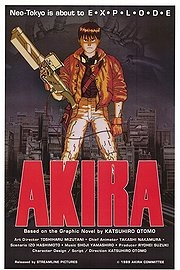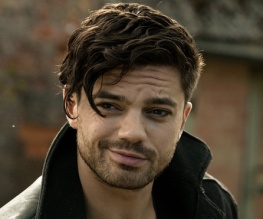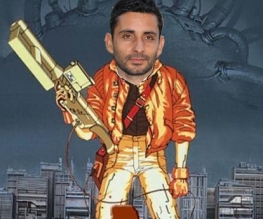Akira

The year is 2019, and 31 years have passed since a mysterious nuclear catastrophe destroyed Tokyo and instigated a third World War. In the convening period an apparent peace has been reached and the Japanese capital has been reconstructed as ‘Neo Tokyo’, a swollen and labyrinthine metropolis located on an artificial island in Tokyo bay. While superficially prosperous, a closer look into the neon-lit shadows of the city’s towering edifices reveals the harsh reality. In the streets it’s a story of drug dens, riots, daily terrorist bombings and juvenile gangs of marauding bikers – a nihilistic youth who live only for senseless violence and turf war.
One such gang (the ‘Capsules’, led by a brash and bold young delinquent named Kaneda) are out cracking skulls on the city’s expansive expressways one night when one of their number, Tetsuo, gets separated from the group. Pursuing a rival gang member, Tetsuo eventually careers into a creepy green child and both are enveloped in an explosion. Arriving on the scene, Kaneda and co find a stricken Tetsuo being whisked away by shady G-Men, along with the (completely unharmed) mutant child. Taken to a government medical facility, Tetsuo begins to experience certain psychic changes that leave the fate of Neo-Tokyo hanging in the balance…

Words fail when it comes to describing exactly how visually stunning Akira is. Immediately you are struck with the sheer scale of the interlocking urban sprawl that is Neo-Tokyo and the minute and detailed rendering of its streets and inhabitants. But more impressive than the physical scale of the Akira universe is the staggering breadth of creative imagination on display, and this is something which is not just evident in the incomprehensibly vast cityscape, but later with Tetsuo’s hallucinatory mental breakdown and eventual psychical transformation.

It’s a triumph of more than style and substance, and Akira’s 20 year old animation manages to achieve what painfully few modern live-action films can manage: gripping and dynamic action scenes. It’s superbly directed from the numerous chase sequences to the intensifying scenes of mass destruction as Neo-Tokyo disintegrates around its denizens. These epic scenes culminate in a final confrontation which is akin to Cronenbergian body horror on a Lovecraftian scale, something truly awe-inspiring which, even with all the explosions in the world, Michael Bay couldn’t hope to recreate.
Both the visuals and the sound are greatly helped by the restoration, which while being immediately noticeable is subtle enough to not interfere with the classic, retrofuturistic aesthetic which defines the movie. Similarly the big-screen edit which shortens the feature by some 20 minutes does make for some rather abrupt cuts, but can equally be said to add a welcome quicken of pace.

Just as Akira’s original release might have been mistakenly dismissed as an exercise in novelty, this resurrection might equally be condemned as an exercise in nostalgia. But novelty and nostalgia simply don’t do it justice – Akira was not only the first, but also the best, and similarly not only a classic movie but also a timeless one.
(Jim saw Akira at the Barbican Centre, which is showing a huge variety of animated films all through the summer. Find out more here!)





Recent Comments